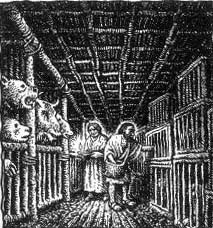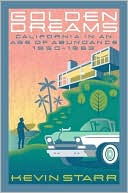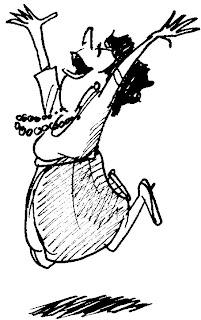As nearly as I can remember, the only time I ever showed the least interest in comics was when I was little and my dad used to read the “funnies” to me from the evening newspaper. I listened and looked while he read Moon Mullins, Blondie and Dagwood, Li’l Abner, and Dick Tracy; those are the only ones I can remember. Now that I think about it, I do remember always reading Pogo when I was a teenager in the late 40s. But for the most part comics have not been anything I was interested in.
So that is why I am surprised at my glee over the R. Crumb book - “The Book of Genesis, Illustrated” that I blogged about sometime ago. On the cover it says, “All 50 Chapters” and “Adult Supervision Recommended for Minors” and “The First Book of the Bible Graphically Depicted! Nothing left out!” It truly is what it says it is and moreover, it is truly amazing.
Every time I picked it up I would have to interrupt Jerry periodically to say, “Look at this; Listen to this! You’ll LOVE this!” And other times he laughed heartily at the same things I did, which doesn’t always happen. And sometimes he said, “Oh My!”
The illustrations are superb. His rendering of God is perfect, and I will have to say that God appears just about how I would have drawn him if I were an illustrator, (although I can’t draw anything recognizable so I’m off the hook there.) Crumb’s creation sequence is really ‘right on.” My first surprise was about Noah and the ark.

Now who would ever have depicted the inside of Noah’s ark like this? The best way I can describe it is that if Jerry had an ark, his would look like this. Mine would look like every picture I’ve every seen of animals in the ark in picture books and Sunday school papers – full to overflowing with animals running around, getting into things, leaning over the rails – total bedlam! Crumb’s ark is so Jerry-like. And it never entered my mind to think of such a tidy ark. That made me laugh.
Another thing that made me laugh the most was when Joseph was in Egypt – had been in Egypt for enough years that obviously he spoke in an “Egyptian” language, but when his brothers arrived, who would not have been able to understand him, Joseph had a translator – and Crumb’s depiction of the event looked like this.

Don't you think this is hystericallly funny? Crumb didn’t need words of explanation to tell us what was going on. And as these conversations between Joseph and his brothers went on a long time over many sessions, Crumb doesn’t waiver in his hieroglyphics! You get the original and the translation page after page after page – and I have to tell you, both Jerry and I laughed and laughed about this. How clever. What a creator Crumb is.
And then if it is at all possible to make the begats even a tiny bit more interesting than they really are (and if any of you have tried to read through Genesis, including those begats, you’ll know how very tedious and boring they can be) – but Crumb doesn’t bat an eyelash at them. If Genesis says “This is the lineage of So and So” – then Crumb starts drawing faces of each of the people who were begat, and their sons and daughters as well. And they all look different! Can you imagine drawing dozen and dozens of different faces?

Now when I got to Jacob and his twelve sons, I was just very pleased. I’ve always known the story, and when I was in Jerusalem I bought a set of postcards of Marc Chagall’s famous stained glass windows at the Hadassah Medical Center, one representing each of Jacob’s sons. But never would I have expected anywhere to see faces of those twelve sons staring at me from a book. No one knows what they really looked like but Crumb doesn’t let that stop him. Such an amazing bit of art work.
I could go on and on. I have thoroughly enjoyed reading and browsing through this book. It is a visual treat, even for a person who normally does not like comics. I can imagine some rigid religious people thinking this book should be left alone. It does depict quite graphically the business of men “knowing” their wives, (which actually I find a little bit easier to take than the slaughtering of sheep and goats for offerings). But I have found myself impressed, delighted and enthusiastic about it.
Hats off to Mr. Crumb and his amazing talent and for taking on a project such as this, which incidentally he says took five years to complete. If R. Crumb doesn't win some top prizes for this astounding book, then life really, really ain't fair at all!









































